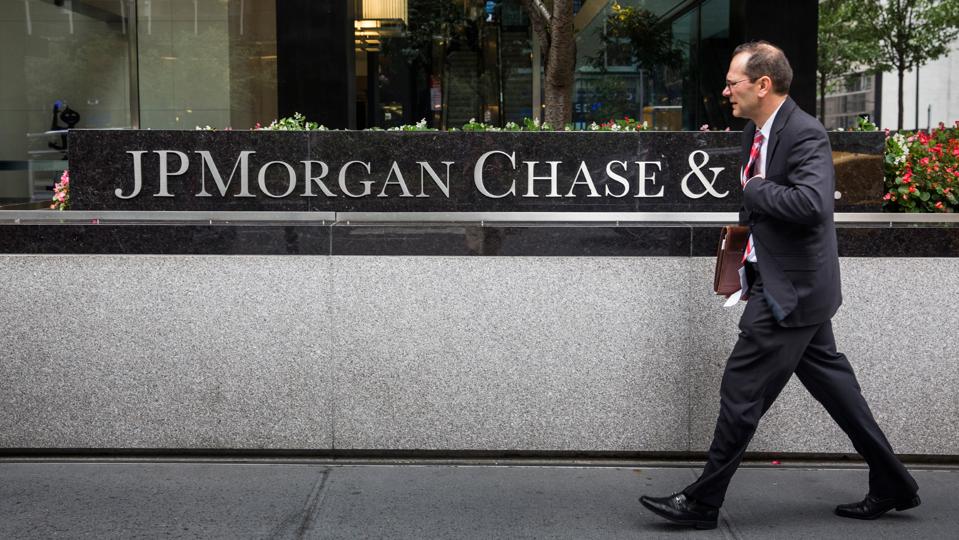TOPLINE
While many of the nation’s largest banks saw their profits plunge during the second quarter, trading revenues have surged, enabling banks to maintain strong capital positions and better position themselves to weather the coronavirus pandemic.
Banks with a focus on trading are seeing better results than those with traditional lending … [+]
Andrew Burton/Getty Images
KEY FACTS
Investors have piled into the stock market amid unprecedented volatility this year resulting in a major boost to trading revenues at the nation’s major banks.
And while the focus during this earnings season has been on bank losses this quarter, the market isn’t appreciating how much banks are benefiting from a good sales and trading environment, says Ian Lapey, portfolio manager of the Gabelli Global Financial Services Fund.
Surging trading revenues are helping banks—especially those with large investment banking divisions—book big reserves to weather the coronavirus recession.
“That will allow them to protect future earnings along with capital markets issuance—and that business has been booming,” says Lapey.
The biggest difference between the coronavirus recession and the 2008 financial crisis is that “financial institutions today are fairly stable and robust,” says Omar Aguilar, chief investment officer of passive equity and multi-asset strategies at Charles Schwab.
“In fact, most financial institutions are part of the solution as opposed to being part of the problem in 2008,” when capital markets closed down and investment banks faced significant losses, Aguilar points out.
Today’s markets, by comparison, have remained “very liquid” thanks to massive support from the Federal Reserve, which means high yield and debt issuance that is good for banks, says Lapey. Banks are “much better positioned than last time around,” he agrees.
But not all banks are seeing the full benefits of the trade surge: Bank of America and Wells Fargo are setting aside larger loan reserves, and as a result, they’re posting earnings that are less impressive than banks with strong capital markets activity, like JPMorgan or Goldman.
“So, clearly, you’re seeing the banks who have a higher proportion of investment banking and trading divisions as opposed to traditional lending are doing much better,” says Lapey.
Morgan Stanley
The bank handily beat analyst estimates for the second quarter thanks to stronger-than-expected trading revenues. Fixed-income traders posted a nearly 170% revenue increase, while equity traders saw revenue jump 23%. Morgan Stanley’s investment banking revenue climbed 39%, boosted by a boom in debt and equity issuance.
Bank of America
While Bank of America also saw a surge in trading revenues that helped offset damage from the coronavirus pandemic, the results were less impressive than those of rivals like JPMorgan and Goldman Sachs. While bond trading revenue was up 50%, equity trading revenues were up only 7%. But the lender also had to set aside $4 billion of reserves for credit losses causing its stock to fall.
Goldman Sachs
Goldman posted a blowout second quarter on the back of its best trading results in years. The bank’s heavy focus on trading and investment banking, which made up around 75% of its revenue during the quarter, paid off amid stock market volatility caused by the pandemic. Trading revenue surged by 93% overall, bond trading revenue alone by 150%, and equity trading revenue by 46%. The bank’s investment banking division saw revenue climb 36%.
JPMorgan
With its strong capital markets activity, JPMorgan “really showed itself to be more resilient in this environment than more traditional banks like Wells Fargo,” says Bill McMahon, chief investment officer of active equity strategies for Charles Schwab. The bank topped expectations thanks to a 79% percent jump in trading revenue. Bond trading was especially profitable, with revenue increasing 120% from a year earlier.
Wells Fargo
As a commercial bank and traditional lender less focused on trading and investment banking, Wells Fargo faced steeper losses. The bank reported a $2.4 billion loss—its first quarterly loss since the 2008 financial crisis—and slashed its dividend to 10 cents per share. “Wells Fargo is more of a restructuring story with new management,” says Lapey, adding that beyond recently changing CEOs, the firm had “all sorts of issues” even before the pandemic.
Citigroup
Citi also topped earnings estimates thanks to strong trading results. The bank reported that its fixed-income trading revenue rose nearly 70% year over year, accounting for most of its Markets and Securities Services revenues, which rose almost 50% overall. While Citi “did terribly during the last crisis,” Lapey says, “now they’ve spent eight years preparing for a recession.” The bank has been able to continue its dividend, benefited from strong leadership and positioned its balance sheet “much more conservatively,” he says.
Full coverage and live updates on the Coronavirus
